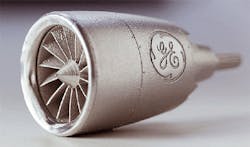GE Opens Additive Manufacturing Development Center
General Electric opened a new operation near Pittsburgh it said will be its “flagship center for additive manufacturing,” a place where it will it will develop and implement industrial products and technologies for all the various GE businesses.
GE has been a pioneer in the application of additive manufacturing, in particular within the GE Aviation business, which has adopted additive manufacturing (or 3D printing) to produce fuel nozzles and other engine parts.
The Center for Additive Technology Advancement (CATA) in Findlay Township, Penn., is a $39-million project that GE said would employ 50 engineers ranging in their disciplines from mechanical and electrical design to systems and software engineering.
According to GE, it is its first multi-modal site in the U.S., designed as “an innovation hub” where both designs and applications will be developed.
GE has described a corporate vision that “the intersection of technology and manufacturing” (combining hardware with software) will defined the way that the business develops and manufactures (and services) products in the future. The CATA location will combine lean manufacturing resources with “advanced software analytics” to improve the application of additive manufacturing across the GE organization.
Together with the CATA opening, GE released a white paper — The Future Workforce: Advanced Manufacturing’s Impact on the Economy —detailing advanced manufacturing’s impact on jobs, and the future of work. It said CATA’s job creation effects would demonstrate the paper’s findings, as advanced manufacturing accounts for 13% of all jobs in the U.S. and contributes $3.1 trillion to the economy. GE also contended that every advanced manufacturing job supports 3.5 jobs through the supply chain, and that the average salary for a technologist in the industry is $95,000.
“Today’s opening is strong evidence that GE is leading the digital transformation of industry, starting with a hub for the advancement of additive manufacturing techniques,” stated chief productivity officer Philippe Cochet. “The application of insights from digital connectivity in collaboration with intelligent devices will elevate the skills of our workforce, streamline productivity and enhance product development overall.”
